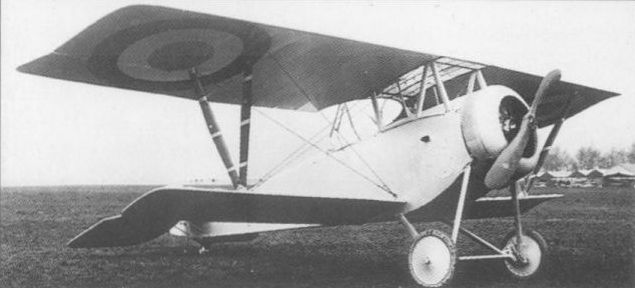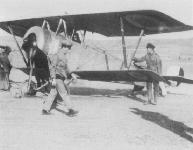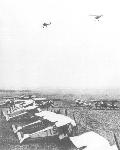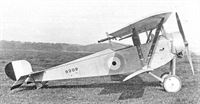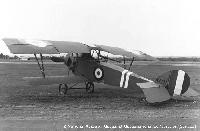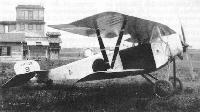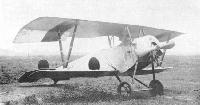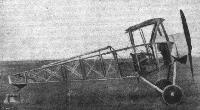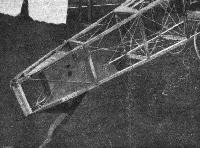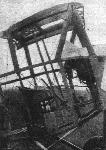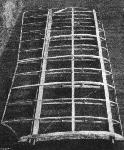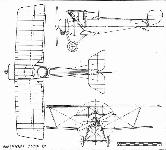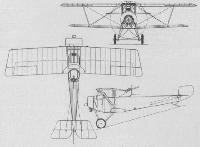В.Кондратьев Самолеты первой мировой войны
Nieuport 12/12bis
На базе "Ньюпора-10AR" Деляж разработал улучшенную модификацию - "Ньюпор-12", оснащенную 110-сильным мотором "Рон" 9J или "Клерже" 9Z той же мощности. На некоторые машины поздних серий ставили 130-сильные "Клерже" 9B. Самолет имел слегка увеличенные размеры, но главным внешним отличием от предшественника стали межкрыльевые стойки, установленные с "развалом" наружу. Благодаря более мощным моторам летные данные машины заметно улучшились. В задней кабине летнаба обычно устанавливался подвижный пулемет "Льюис" на простой шкворневой установке.
В 1916 году выпускалась двухместная модификация "Ньюпор-12bis" с улучшенной аэродинамикой (круглый капот, вместо подковообразного, и более плавные переходы от капота к плоским бортам фюзеляжа, аналогичные тем, что были у "Ньюпора-17"). Основное вооружение составлял пулемет "Льюис" на турели "Этев" в задней кабине.
"Ньюпоры-12" активно применялись французскими летчиками в качестве разведчиков и двухместных истребителей до зимы 1916-17 годов, после чего их вывели из состава фронтовых эскадрилий, разоружили и переквалифицировали в учебные машины. В этом качестве они прослужили до конца войны.
Помимо Франции, "Ньюпоры-10" и -12 выпускались серийно и состояли на вооружении в Италии, Великобритании, и России. Кроме того, на "десятках" французской постройки летали бельгийские и американские летчики. Отдельные экземпляры попали в Португалию, Бразилию, Японию, Таиланд и некоторые другие страны.
Английская морская авиация получила 169 "Ньюпоров-10" и -12, из которых 50 штук были построены в Великобритании на фирме "Бердмор Компани". Итальянская фирма "Ньюпор-Макки" построила 260 таких самолетов, а московский завод "Дукс" - примерно 100 "Ньюпоров-10" в одноместном (истребительном) и двухместном вариантах.
"Ньюпоры" фирмы "Бердмор" имели слегка видоизмененное вертикальное оперение с небольшим килем, по форме напоминавшим киль"Ньюпора-24".
Российские "Ньюпоры-10" и -12 использовались на русско-германском фронте вплоть до прекращения там боевых действий, а несколько десятков из них еще успели принять участие в гражданской войне.
Всего в 1915-16 годах выпущено более 1000 "Ньюпоров-10", -12 и -12bis.
Показать полностью
А.Шепс Самолеты Первой мировой войны. Страны Антанты
"Ньюпор-12", "Ньюпор-14" 1915 г.
Создавая новый истребитель, фирма продолжала совершенствовать двухместный вариант разведчика. Новая машина была немногим меньше, чем "Ньюпор�10", двигательная установка была аналогичной "Ньюпор-11". Конструктивных отличий практически не было. Пулемет "Льюис" на турели у наблюдателя и синхронный "Виккерс" перед кабиной пилота составляли вооружение самолета. Для обеспечения обзора пилоту верх центроплана имел прозрачную целлулоидную обшивку. В отличие от "Ньюпор-10", элероны сужались к концам крыльев, а стойки монтировались с некоторым развалом. Вариант с двигателем "Клерже" (110 л. с.) получил обозначение "Ньюпор�12�бис". На базе разведчика фирма выпустила учебный самолет "Ньюпор�13B" с двигателем "Рон" (80 л. с.) и двойным управлением. Все эти самолеты выпускались небольшими сериями, так как основные мощности фирмы были направлены на обеспечение фронта истребителями "Ньюпор-11", а позднее - "Ньюпор-17". Для достижения лучших летных качеств самолета фирма построила на базе "Ньюпор-12" разведчик "Ньюпор-14" с рядным двигателем "Испано-Сьюиза" HS-8A (150 л. с.) или HS-8Aa (175 л. с.). Скорость возросла, но машина оказалась перетяжеленной, приобрела переднюю центровку, была строга в управлении и склонна к срыву в штопор. Распространения не получила.
Показатель "Ньюпор-12" "Ньюпор-13В"
1915г. 1915г.
Размеры, м:
длина 7,30 7,10
размах крыльев 9,15/7,8 9,0/7,8
высота 2,8 2,8
Площадь крыла, м2 23,0 23,0
Вес, кг:
максимальный взлетный 920 880
пустого 550 550
Двигатель: "Клерже" "Клерже"
мощность, л. с. 110 110
Скорость, км/ч 146 144
Дальность полета, км 320 300
Время набора высоты
2000 м., мин 19,0
Потолок, м 4700 4300
Экипаж, чел. 2 2
Вооружение 2 пулемета
Показать полностью
В.Шавров История конструкций самолетов в СССР до 1938 г.
"Ньюпор-XII" - двухместный разведчик несколько больших размеров, но той же схемы. Вооружение - один неподвижный пулемет с синхронизатором и один подвижный на турели. По внешнему виду отличался от одноместных "Ньюпоров" прозрачной целлулоидной обшивкой центроплана, суженными на концах элеронами и слегка наклонными (при виде спереди) стойками коробки крыльев. Имелся в нескольких импортных экземплярах, в России не строился. Двигатель - "Клерже" в 110 л. с. Два экземпляра с двигателями "Клерже" в 130 л. с. назывались "Ньюпор-XII бис". Был еще учебный вариант под названием "Ньюпор-XIII-B" с двигателем "Рон" в 80 л. с. и двойным управлением, приобретенный в одном экземпляре. Подобный же двухместный разведчик "Ньюпор-XIV" с двигателем "Испано-Сюиза" в 150 и 175 л. с. был приобретен, но на фронте не был.
Самолет||
Год выпуска||1916
Двигатель, марка||
мощность, л.с.||110
Длина самолета, м||7,1
Размах крыла, м||9
Площадь крыла, м2||23
Масса пустого, кг||550
Масса топлива+ масла, кг||107
Масса полной нагрузки, кг||325
Полетная масса, кг||875
Удельная нагрузка на крыло, кг/м2||38
Удельная нагрузка на мощность, кг/лс||8
Весовая отдача,%||37
Скорость максимальная у земли, км/ч||144
Время набора высоты||
1000 м, мин||4,5
2000 м, мин||10,5
3000 м, мин||20
4000 м, мин||35
Потолок практический, м||4300
Продолжительность полета, ч.||2,5
Показать полностью
J.Davilla, A.Soltan French Aircraft of the First World War (Flying Machines)
Nieuport 12
The Nieuport 10 with its 80-hp Le Rhone engine was too underpowered to be useful as a reconnaissance aircraft. In order to overcome this problem an enlarged version of the Type 10 with a 110-hp Clerget 9Z rotary was introduced in 1915. A pilot was seated under a cutout in the upper wing; the center section of the wing had a transparent covering to provide the pilot with a better upward view. The observer/gunner sat behind the pilot and had a Lewis machine gun on an Eteve mounting. In some aircraft a second gun was fitted to the top wing and was aligned to fire over the propeller. The wings were of unequal span and had the V-interplane struts with an outward rake. Later aircraft had the more powerful 130-hp Clerget 9B engine and a circular cowling faired into the fuselage. This type was designated the Nieuport 12bis and was supplied only to French units. The Nieuport 12bis C2 was a two-seat escort fighter with two Lewis guns.
Operational Service
Contemporary assessments note that the Nieuport 12 had an inferior performance, vibrated excessively, was difficult to fly, and even more difficult to land. Despite the modifications to the top wing, the pilot's view was still described as poor. Nonetheless, the aircraft saw widespread use with French fighter escadrilles and supplanted the inferior Nieuport 10 in the reconnaissance role. Nieuport 12s served primarily with Nieuport 11, 16, and 17-equipped escadrilles being used for short-range reconnaissance and also to transport spies behind enemy lines.
In addition to the Nieuport escadrilles, Nieuport 12s were also assigned, usually in batches of one to three, to various other French units.
Nieuport 12s often made up a substantial portion of an escadrille's strength. For example, during the Somme offensive N 38 had five Nieuport 12s and five Nieuport 11s in service. N 49 was equipped with 14 airplanes in March 1914; five were Nieuport 12s. By May of that year the six Nieuport 12s on strength constituted one-half of N 49's entire force. Nieuport 12s actually made up the major part of N 77's equipment from its formation in September 1916 until mid-1917.
The records of these escadrilles show that the Nieuport 12s were used for a large number of mundane but important and often dangerous missions. N 77 used its Nieuport 12s not only for reconnaissance, but also for ground-attack, while the Nieuport 12s of N 38 were used for reconnaissance, barrage flights, and even air-to-air combat. In the latter role, however, the Nieuport 12s proved no match for the superior German airplanes and the unit had few victories.
By February 1916 there were 120 Nieuport 10s and 12s in service at the front. However, the Nieuport 12s were replaced as 1916 progressed and by 1917 only four examples with 130-hp Clergets were still in service at the front. A total of 7,200 Nieuport 10s and 12s were built during the war.
The Aviation Maritime also purchased a number of Nieuport 12s; these were based at the various naval aviation centers. The primary missions of the Nieuport 12s were reconnaissance and escort for the more vulnerable flying boats.
Foreign Service
Chile
In 1918 the Chilean air service purchased a single Nieuport 12.
Estonia
The Estonian Aviation Company was formed in 1920 and acquired a single Nieuport 12, probably from Russia. It was given serial number 52.
Poland
The Polish 10th Squadron had several Nieuport 12s on strength in 1920.
Russia
A small number of Nieuport 12s were imported from France and used by the Imperial Russian Air Service. Those with 130-hp Clerget engines were designated Nieuport 12bis. The Nieuport 13 B was a dual-control trainer with a 80-hp Le Rhone engine.
On 1 April 1917 there were only three Nieuport 12s in frontline service. By June that number had increased to ten, four on the western Front and six on the southwestern/Romanian front.
Two Nieuport 12s, one serving with the 1st Military School of Pilots, were in service until 1925.
Siam
Siam obtained at least one Nieuport 12 from France postwar. It was used as a trainer until 1933 and carried serial number 1.
United Kingdom
The Nieuport 12 was also used by the RNAS and RFC. The RNAS had concluded that the Nieuport 10s were too underpowered to be useful as a two-seat reconnaissance airplane. The more powerful Nieuport 12 was purchased in large numbers by the RNAS. In addition to its use as an observation plane, some Nieuport 12s were modified as single-seaters to serve as fighters. A total of 194 Nieuport 12s were used by the RNAS; all were built in France with the exception of 9201-9250. They carried serial numbers 3920-3931; 8510-8515; 8524-8529; 8708-8713; 8726-8744; 8902-8920; N3170-N3173; N3174-N3183; and N 3188. These served with Nos.1, 2, 4, and 5 Wings and in the Aegean.
The Beardmore firm built 50 under license; these featured a fixed fin ahead of the rudder as well as a cowling completely encircling the engine. The Beardmore machines were allotted serials 9201-9250 and saw service with Nos.1, 2, and 5 Wings. Later, many were transferred from the RNAS to the RFC.
A total of 122 Nieuport 12s had 110-hp Clerget engines and the other 72 had 130-hp Clergets.
As noted above, the Nieuport 12s were used by No. 1 Wing (Dunkerque), No.2 Wing (Imbros), No.3 Wing (Dardanelles), No.7 Squadron (Petite Snythe) and No.10 Squadron (Dunkerque; later assigned to No.4 Wing). During the Battle of the Somme a number of the RNAS Nieuport 12s were transferred to the RFC. These were assigned to No.46 Squadron which used the Nieuport 12 from April 1916 until April 1917. The Nieuport 12s were despised by the British crews, who felt that it was dangerous to fly and had unacceptably poor performance. They were later replaced by Nieuport 20s.
Nieuport 12 Two-Seat Reconnaissance Aircraft with 110-hp Clerget 9Z
Span 9.00 m length 7.10 m height 2.70 m wing area 22.00 sq. m
Empty weight 550 kg; loaded weight 825 kg (120 kg fuel and 180 kg armament)
Maximum speed: 146 km/h at 2,000 m; climb to 1,000 m in 5 minutes 40 seconds; climb to 2,000 m in 14 minutes 15 seconds; ceiling 4,000 m; range 500 km; endurance 3 hours
Armament: one fixed 0.303 Vickers machine gun and one 0.303 Lewis machine gun on an Steve mount
7,200 Nieuport 10s and 12s were built
Nieuport Reconnaissance Aircraft with 150-hp Le Rhone Engine
This aircraft was built in November 1916 and may have been a development of the Nieuport 12. It was a two-seat biplane powered by a 150-hp Le Rhone engine. The aircraft was not ordered by the Aviation Militaire.
Nieuport 20
The Nieuport 20 was a development of the Nieuport 12 produced for the RFC in 1916. While it had the basic Nieuport 12 airframe there were major changes, including a 110-hp Le Rhone engine, a horseshoe cowling, and fuselage fairings. The fuel tank was enlarged and its shape altered. The pilot and observer were seated back-to-back and the observer had a 0.303 Lewis gun. The pilot had a synchronized 0.303 machine gun. Twenty-one (of 30 ordered) were purchased by the RFC.
Some Nieuport 20s were equipped with a 120-hp Le Rhone engine. The airframes were otherwise unchanged. They were designated Nieuport 20bis.
The Nieuport 20 was assigned to Nos.1, 45, and 46 Squadrons. As with the Nieuport 12, the aircraft were not liked by the aircrew and were replaced in early 1917. When these aircraft were withdrawn from service they were assigned to Nos.65 and 84 Training Squadrons, as well as Nos.31, 43, 45, and 55 Reserve/Training Squadrons. Some were also used by No.39 Home Defense Squadron.
Nieuport 20 Two-Seat Reconnaissance Airplane/Fighter with 110-hp Le Rhone 9J
Span 9.00 m; length 7.00 m; height 2.70 m; wing area 22 sq. m
Empty weight 453 kg; loaded weight 752 kg
Maximum speed: 157 km/h at sea level, 152 km/h at 2,000 m; climb to 1,000 m in 5 minutes 12 seconds; climb to 2,000 m in 12 minutes 2 seconds
Armament: one fixed 0.303 Vickers machine gun and one 0.303 Lewis gun on an Eteve mount
A total of 21 aircraft were obtained by the RFC; none were used by the Aviation Militaire
Nieuport 80 Trainer
As noted earlier, the Nieuport 10 was a two-seat reconnaissance airplane. When it was replaced in service by the Nieuport 11, the Nieuport 10s were turned over to the training schools. These aircraft, two-seaters with communal cockpits, were ideal in the training role. A few modifications were made to many of them and they received a designation in the "80" series. The reason for the unusual numbering has never been adequately explained. It is believed that the number denoted the fact that the aircraft was powered by an 80-hp engine. The designation does not appear in the STAe list of approved aircraft appellations.
The Nieuport 80 was the first two-seat trainer in this series and appeared in 1917. Its dimensions were identical to the earlier Nieuport 10, although it was slightly heavier. While some Nieuport 80s had dual controls and were designated E2s, others were single-seaters designated as Nieuport 80 E1s.
In the French training system the Nieuport 80s were used as primary trainers. From these (as well as M.F.11s, Caudron G.3s, and G.4s) the pilot would move on to the advanced flying schools. Training took place at numerous airfields including Buc, Amberieu, Chateauroux, Bron, and Tours.
Foreign Service
Brazil
A French aerial mission to Brazil in November 1918 brought ten of the single-seat Nieuport 80 E1s. These were used at the Escola de Aviacao Militar (Military Aviation School) in Campo dos Afonsos. They were given serials 8001 through 8010. The Nieuport 80 E1s were struck off charge in 1924.
Portugal
The Escola de Aeronautica Militar (Military Aviation School) of the Portuguese Aeronautica Militar received three Nieuport 80 E2s in 1919.
Japan
A single example of the Nieuport 80 trainer was purchased by the Japanese after the war.
United States
The A.E.F. Air Service purchased 147 Nieuport 80 E1s. The American training syllabus (which was closely modeled on the French system) called for the student pilot to graduate from the Breese Penguin to the Nieuport 80. Primary training centers were located at Foggia, Tours, Avord, Chateauroux, Voves, and Vendome.
Nieuport 80 Single-Seat or Two-Seat Trainer with 80-hp Le Rhone
Span 7.90 m; length 7.00 m; wing area 18 sq. m
Empty weight 440 kg; loaded weight 690 kg
Maximum speed: 140 km/h; climb to 2,000 in 17 minutes; range 280 km
Nieuport 81
The Nieuport 81 was the second in a series of two-seat trainers based on earlier Nieuport designs. It appears to be closely based on the Nieuport 12, although its wing area was one square meter larger. The aircraft had two separate cockpits with dual controls. The 110-hp Clerget engine was replaced by an 80-hp Le Rhone, which may explain the "80" series designation.
The Nieuport 80s were used as primary trainers, the pilots then moving on to the more sophisticated Nieuport 83s, Nieuport 11s or 17s, or Sopwith 1 1.2 Strutters. The Camplan School at Bordeaux-Merignac retained its Nieuport 81s until 1923.
Foreign Service
Belgium
Belgium purchased a single Nieuport 81 for evaluation.
Brazil
Brazil received Nieuport 81 E2s in 1919. They were given serial numbers 7513 and 8101-8108 and assigned to the Escola de Aviacao Militar at Campo dos Afonsos. Some of the Type 81s were later converted to taxi trainers ("penguins"). The Nieuport 81s remained in service until 1924.
Japan
Forty Nieuport 81 E2s were brought to Japan in 1919 by a French aviation mission. Mitsubishi built Nieuport 81 E2s under license for the army, the first being completed by May 1922. The Japanese designation was Ko 1. The trainers were used at the Tokorozawa Flying School beginning in 1922. Others served with various air regiments and with the Kagamigahara Airfield.
United States
The A.E.F. Air Service purchased 173 Nieuport 81s. These were probably used as primary trainers in the same manner as the Nieuport 80s (see above).
Nieuport 81 Single-Seat or Two-Seat Trainer with 80-hp Le Rhone
Span 9.05 m; length 7.14 m; wing area 23 sq. m
Empty weight 490 kg; loaded weight 760 kg
Maximum speed: 130 km/h; climb to 2,000 m in 19 minutes; range 260 km
Nakajima Ko 1 Nieuport 81 Single-Seat or Two-Seat Trainer with 80-hp Le Rhone
Span 9.20 m; length 7.20 m; height 2.60 m; wing area 23 sq. m
Empty weight 490 kg; loaded weight 760 kg
Maximum speed: 70 kts; ceiling 4,000 m
57 built
Nieuport 82
The Nieuport 82 appeared to be a modified (probably rebuilt) version of the Nieuport 12. It featured a much larger wing span than the Nieuport 12 with the wing area increased by nearly 40 percent. This aircraft also had large wheels added ahead of the main landing gear to prevent it from nosing over on landing. As with all the aircraft in the "80" series the engine was a 80-hp Le Rhone. There was a single cockpit for both the pilot and the student. Some reports suggest these were rebuilt from Nieuport 14 army cooperation aircraft that were rejected as unsuitable for front-line service; other reports suggest that the Nieuport 82 was developed from the unsuccessful Nieuport 15 bomber. The Nieuport 82 was nicknamed La Grosse Julie.
The Nieuport 82s, along with the Nieuport 80 and 81, served as primary trainers.
Brazil purchased seven Nieuport 82s. Given serials 2380, 4767, 8049, 8064, 8065, 8069, and 8070, they remained in service at the Escola de Aviacao Militar at Campo dos Afonsos until 1924.
Nieuport 82 Single-Seat or Two-Seat Trainer with 80-hp Le Rhone
Span 12.10 m; length 7.88 m; wing area 30 sq. m
Empty weight 550 kg; loaded weight 820 kg
Maximum speed: 110 km/h; range 220 km
Nieuport 83
The Nieuport 83 was the last in the line of two-seat trainers powered by 80-hp Le Rhone engines. It had dimensions nearly identical to the Nieuport 80 and was probably a rebuilt Nieuport 10. The aircraft featured the communal cockpit of the Nieuports 10 and 82. In addition, the struts were mounted vertically and did not have the outward cant that preceding Nieuports used. Also, unlike the other "80" series trainers, the Type 83 had straight ailerons with no washout. Some did not have dual controls.
The French probably used the Nieuport 83s as primary trainers.
Foreign Service
Brazil
The Brazilian Escola de Aviacao Militar at Campo dos Afonsos received 14 Nieuport 83 E2s (dual controls) in 1919. They were given serial numbers 8877, 8889, 8890, 8894, 8901, 8902, 8908, 8909, 8910, 8915, 8917, 8919, 8921, and 8922. They remained in service until 1924.
Italy
A version of the Nieuport 83 was produced by the Nieuport-Macchi firm, designated the Type DC 10.000.
Japan
Japan imported several Type 83s in 1919. The type was license-built by Nakajima. Designated Ko 2, the Nieuport 83 E2s were used by the Tokorozawa Army Flying School, the air regiments, and at the Kagamigahara Airfield until 1926.
Portugal
Portugal purchased seven Nieuport 83 E2s in 1916. They were assigned to the EMA (Escuela Militar de Aviaco).
United States
The A.E.F. Air Service purchased 244 examples of the Nieuport 83 E2. The syllabus called for the student pilot to graduate from the Nieuport 80 or 81 primary trainers to the Nieuport 83 E2. Advanced training for American pilots was undertaken at Avord, Foggia, and Issoudon. From the Nieuport 83, the pilot advanced to the Nieuport 24.
Uruguay
Uruguay obtained six Nieuport 83s in 1921. They were based at Paso de Mendoza.
Nieuport 83 Single-Seat or Two-Seat Trainer with 80-hp Le Rhone
Span 7.90 m; length 7.0 m; height 2.70 m; wing area 18 sq. m
Empty weight 450 kg; loaded weight 700 kg
Maximum speed: 140 km/h; climb to 2,000 m in 26 minutes
Nakajima Ko 2 Nieuport 83 Single-Seat or Two-Seat Trainer with 80-hp Le Rhone
Span 8.10 m; length 7.035 m; height 2.9 m; wing area 18.40 sq. m
Empty weight 440 kg; loaded weight 710 kg
Maximum speed: 76 kts; ceiling 5,000 m; endurance 2 hours 40 built
Показать полностью
W.Green, G.Swanborough The Complete Book of Fighters
NIEUPORT 12 France
A larger, more powerful derivative of the Nie 10, the Nie 12 was conceived as a two-seat reconnaissance fighter. Soon after its service debut with the Aviation Militaire it was successfully operated as an escort fighter. Powered by a 110 hp Clerget 9B rotary, the Nie 12 had an armament comprising a single machine gun on a ring mounting in the rear cockpit, this sometimes being supplemented by a forward-firing gun braced to the upper wing. Produced in considerable numbers in France for the escort role and supplied to the Imperial Russian Air Service, the Nie 12 was also licence-built in the UK by William Beardmore for the RNAS. The Beardmore-built Nie 12s featured an extended lower wing, some having full engine cowlings and fixed fin and plain rudder replacing the Nieuport balanced rudder. Forty Nie 12s were transferred to the Royal Flying Corps. In 1916, an improved two-seat fighter version, the Nie 12bis with a 130 hp Clerget 9, was introduced by the Aviation Militate. The following data relate to the 110 hp model.
Max speed, 91 mph (146 km/h) at 6,560 ft (2 000 m).
Time to 6,560 ft (2 000 m), 14.25 min.
Empty weight, 1,213 lb (550 kg).
Loaded weight, 1,874 lb (850 kg).
Span, 29 ft 6 in (9,00 m).
Length, 22 ft 11 1/2 in (7,00 m).
Height, 8 ft 10 1/4 in (2,70 m).
Wing area, 236.81 sq ft (22,00 m2).
NIEUPORT 20 France
By mid-1916, the RFC in France possessed a small number of Nieuport two-seaters in which the 110 hp Le Rhone engine had replaced the 110 hp Clerget of the standard Nie 12. This version of the two-seat fighter was apparently built in small numbers only for the RFC with the SFA designation Nie 20. By early August 1916, 30 had been allotted to the RFC by the French authorities, the first two production aircraft being delivered on 15 September 1916. Anxiety to secure as many Nieuport single-seaters as possible led to a reduction in Nie 20 deliveries, only 21 being supplied to the RFC, with which the type saw limited operational use.
Max speed, 98 mph (157 km/h) at sea level.
Time to 6,560 ft (2 000 m), 12.05 min.
Empty weight, 999 lb (453 kg).
Loaded weight, 1,658 lb (752 kg).
Span, 29 ft 6 in (9,00 m).
Length, 22 ft 11 1/2 in (7,00 m).
Height, 8 ft 10 1/4 in (2,70 m).
Wing area, 236.8 sqft (22,00 m2).
Показать полностью
O.Thetford British Naval Aircraft since 1912 (Putnam)
Nieuport Two-Seater
In common with the Nieuport Scout, which it closely resembled in general configuration, the Nieuport two-seater was widely used by the RNAS as well as the RFC.
The early Nieuport 10 two-seater was followed by the larger, improved Nieuport 12. Both types were, as might be expected, of somewhat larger overall dimensions than the Scout and accommodated pilot and observer in closely-coupled cockpits, the pilot being seated immediately beneath the centre section and the observer-gunner level with the trailing edge. Some Nieuport 10s in RNAS service, however, dispensed with the rear gunner and were flown as single-seaters from the rear cockpit, a single Lewis gun being mounted above the top wing to fire above the airscrew disc, as on the normal Scouts. It was a Nieuport of this type (No.3172) that was being flown by Squadron Commander Bell Davies on 19 November 1915 when he won his Vc.
The original batches of Nieuport two-seaters in British service were purchased from the French industry, but later the type was built in Britain. The British-built Nieuports differed from the earlier model (shown in the three-view drawing) in having a fixed fin and a fully circular cowling instead of the cutaway type. Fifty were built for the Admiralty by Beardmore in 1916, the serial numbers being 9201 to 9250. Later, some of these aircraft (Nos.9213 to 9232) were transferred to the RFC as A5183 to 5202. Altogether the RNAS received 194 Nieuport two-seaters: 72 had the 130 hp Clerget engine and the remainder the 110 hp Clerget.
The Nieuport two-seaters did some good work with the Dunkirk Wing in combat with German aircraft along the Belgian coast. A typical engagement was that of 14 December 1915 when F/Sub-Lt C W Graham, with Sub-Lt A S Ince as observer, shot down in flames a German seaplane which was attempting to bomb an Allied merchant steamer stranded on a sandbank. The Nieuport crew were forced down in the sea, but were rescued by the mine-sweeper Balmoral.
UNITS ALLOCATED
NO.1 Wing, RNAS, Dunkirk; No.2 Wing, RNAS, Imbros; No.3 Wing, RNAS, Dardanelles; No.5 Wing, RNAS, Petite Synthe; No.7 (Naval) Squadron, Petite Synthe; No.10 (Naval) Squadron, 5t Pol.
TECHNICAL DATA (NIEUPORT 12)
Description: Two-seat fighting, reconnaissance and bombing aircraft. Wooden structure, fabric covered.
Manufacturers: Soc Anonyme des Etablissements Nieuport, Issy-Ie-Moulineaux (Seine), France. Sub-contracted by Wm Beardmore & Co Ltd, Dalmuir, Dumbartonshire.
Power Plant: One 110 hp or 130 hp Clerget.
Dimensions: Span, 29 ft 7 1/2 in. Length, 23 ft 11 1/4 in. Height, 8 ft 9 in. Wing area, 236 1/2 sq ft.
Weights: Empty, 1,210 lb. Loaded, 2,026 lb.
Performance: Maximum speed, 78 mph at 5,000 ft. Climb, 14 min to 6,500 ft. . Endurance, 3 hr. Service ceiling, 13,000 ft.
Armament: Single free-mounted Lewis gun in rear cockpit for observer or single fixed Lewis gun above top wing when flown as single-seaters.
Показать полностью
G.Swanborough, P.Bowers United States Military Aircraft Since 1909 (Putnam)
NIEUPORT 2-SEAT TRAINERS
The Nieuport Model 10 was one of the first armed tractor two-seaters, with the gunner in the front cockpit standing up with his shoulders through a hole in the upper wing in the pre-synchronized gun days of 1914/15. The famous single-seat Model 11 “Bebe” followed and the Model 12 was a typical armed two-seater of 1915/16, with the gunner in the rear cockpit. Three trainers derived from the Model 12 were procured in quantity by the A.E.F.:- 147 model 80E-2 two-cockpit single control, 173 81D-2 two-cockpit dual control (D meant “double command”, or dual control) and 244 83E-2 with semi-dual controls in a single two-seat “Buddy” cockpit. All used the 80-h.p. Le Rhone 9-C engine.
Показать полностью
R.Mikesh, A.Shorzoe Japanese Aircraft, 1910-1941 (Putnam)
Army Type Ko 1 Trainer (Nieuport 81-E2)
French influence on the Japanese Army resulted in an influx of imported French aircraft for training, starting in January 1919. Among these were 40 Nieuport 81-E2s and as their numbers diminished the Japanese Army decided to supplement them with others built in Japan.
Nieuport 81-E2s and 83-E2s were the standard Army trainers and they were initially manufactured under licence in Japan by the Army at Tokorozawa. But recognizing that manufacturing aircraft was not a function of the military, the production of the Nieuport 81E2 was transferred to Mitsubishi which had recently begun building Navy aircraft, and production of the Nieuport 83-E2 went to Nakajima, a newly formed aircraft manufacturer. All drawings and specifications were furnished by the Army and both aeroplanes remained identical to the French-built aircraft. The first of the Mitsubishi-built aircraft was completed in May 1922.
The identity of these two aircraft changed from the French system beginning in November 1921 when the Army established a new designation system, giving a separate identity symbol to each foreign manufacturer's name: Type Ko for Nieuport, followed by a sequential number for each separate type. The Nieuport 81-E2 therefore became the Ko 1 and the Type 83-E2 became the Ko 2.
These Army trainers served at Tokorozawa from the time the Tokorozawa Army Flying School was opened in 1922. Others served at the Kagamigahara Airfield and with some Air Regiments, some remaining operational until around 1926. These two types, with the Nakajima Ko 3, were the main trainers for the Japanese Army during its initial expansion period. After service with the Army, many were released to civil flying schools.
Single-engine sesquiplane trainer. Wooden structure with fabric covering and some plywood and metal. Crew of two in open cockpits.
80-100hp Le Rhone nine-cylinder air-cooled rotary engine, driving a Regy-type two-bladed wooden propeller.
Span 9.20m (30ft 2 1/4in); length 7.20m (23ft 7 1/2in); height 2.60m (8ft 6 1/4in) tail down; wing area 23sq m (247.578sq ft).
Empty weight 490kg (1,080Ib); loaded weight 760kg (1,675lb); wing loading 33kg/sq m (6.759Ib/sq ft); power loading 7.6kg/hp (16.7Ib/hp).
Maximum speed 70kt (81 mph) at sea level; service ceiling 4,000m (13,123ft).
Fifty-seven built.
Army Type Ko 2 Trainer
In November 1921 the Army developed and used a new identifying system for its standard equipment. In the case of Nieuport aircraft, they were all given the designator Type Ko, making the Nieuport 81 E.2 the Ko 1, and the Nieuport 83 E.2 the Type Ko 2. As with the Nakajima-built Type Ko 3, already described, the Type Ko 1 and 2 were needed in greater numbers than could be imported, so licence-manufacture was planned for these aircraft as well. In keeping with the usual practice, production was started at Tokorozawa, but by this time aircraft manufacturing was being shifted to civil companies. The Army remained responsible for the licence agreement with Nieuport and transferred all production materials to respective companies. In doing this, the Army contracted with Mitsubishi to build the Nieuport 81 E.2 as the Type Ko I, and with Nakajima to build the Nieuport 83 E.2 as the Type Ko 2 in addition to the Type Ko 3.
The first of the Nakajima-built Type Ko 2s was completed in March 1922, and was identical to the Nieuport 83 E.2. Subsequent trainers of both the Type Ko 1 and 2 types were delivered and assigned to Army Flying Schools at Tokorozawa and Kagamigahara, and some Flight Regiments beginning in 1922. They remained in service until around 1926. After that a number was released to civil flying schools.
Single-engine sesquiplane fighter. Wooden structure with fabric covering. Pupil and instructor in open cockpit.
80-100hp Le Rhone nine-cylinder air-cooled rotary engine, driving a Regy fixed-pitch wooden propeller.
Span 8.11 m (26ft 7 1/4in); length 7.035m (23ft 1in); height 2.9m (9ft 6in); wing area 18.40sq m (198.062sq ft).
Empty weight 440kg (970Ib); loaded weight 710kg (1,565Ib); wing loading 38.5kg/sq m(8Ib/sq ft); power loading 8.8kg/hp (19.4Ib/hp).
Maximum speed 76kt (87.5mph) at sea level; service ceiling 5,000m (16,404 ft); endurance 2hr.
Forty built from March to July 1922.
Показать полностью
C.Owers Beardmore Aircraft of WW1 (A Centennial Perspective on Great War Airplanes 69)
The Beardmore Nieuport 12
The admiralty placed a contract with Beardmore for 50 Nieuport 12 two-seat sesquiplanes in 1915 (9201-9250). A sample Nieuport without engine, A8967, was sent to the factory as a pattern aircraft in lieu of complete plans. In 1916
the RFC ordered 20 Nieuports from Beardmore (A5183 - A5202). A. Dunkerfield Jones flew the first Nieuport on 10 May 1916, at the Dalmuir airfield. That year Gen Trenchard asked the RNAS for aircraft for the coming Battle of the Somme. Beardmore Nieuports were transferred direct to the RFC. (See Table of Serial numbers).
Starting on 1 July 1916, the Admiralty agreed that, if possible, three Beardmore Nieuport 2 seater 110 Clerget machines per week, but not less than 2 per week up to a total of 20 machines be supplied to the RFC. These were included with a total of 20 Sopwith 1 1/2 Strutters and 20 Bristol Scouts. In response to a further request that spare parts for the Beardmore Nieuports be supplied with these machines, the Admiralty agreed, but indicated that there would be a delay in providing the spare landing chassis.
The spares that accompanied the Beardmore Nieuports were:
Spare Propellers and Packing Cases for same. 2 per machine.
Sets of Main Planes. 1 per 5 machines.
Landing Chassis complete with wheels. 1 per 2 machines.
Tail units. 1 per 5 machines.
Skid units. 1 per 5 machines.
No.46 Squadron in France received its first Beardmore Nieuport (A3282) on 5 October 1916. This was carried out before a CFS report condemning the Beardmore Nieuport was finalized. In this report the Nieuport was said to be dangerous to fly when carrying a full reconnaissance load.
Beardmore built Nieuport A3288 was subject of a report from the Central Flying School, Upavon in October 1916. This machine was fitted with 110-hp Clerget engine No. 344 A.G.
Listed under instruments were the Rev counter Elliott Mk. II, pressure gauge, watch, compass, inclinometer, aneroid S&M, Airspeed Indicator, Fire extinguisher and the Nieuport “Spider” Gun Mounting.
The machine was considered as having good features for reconnaissance but unsuitable for bomb dropping.
The gunner’s facilities were very good upwards, only fair over the side and downwards and very good to the rear. The pilot had a fixed Vickers with Scarff timing gear.
Lateral stability was good, but longitudinally and directionally it was unstable. It vibrated badly in the air. It was considered tiring to fly due to the cramped position of the pilot. The pilot’s view was not good on account of the high fairing round his cockpit.
When carrying full reconnaissance load it is so heavily loaded as to be not only useless in the matter of performance, but dangerous to fly, whole in any case it is much too bad in climb and speed to be any use as a fighter.
It was estimated that the aircraft took only 150 yards to unstick and pull up. Landing was considered very difficult in a confined space as there was not sufficient elevator control to get the tail properly down.
Under ‘Remarks’ the pilot’s position as again criticized as being very cramped, the rudder bar being much too close. The switch was awkward to reach and would be better positioned on the instrument board. The fine adjustment was difficult to reach and operate. The throttle was placed too near the pilot. The tail plane was much too small. The machine tended to stall with the engine on and dive with the engine off.
Owing to the very bad performance of this machine, it appears that no alterations practicable would render it fit for service overseas.
Prior to this condemnation of the Beardmore machines, there was trouble experienced with those already delivered.
A 25 June 1916, ‘Report on Beardmore Nieuport Machines’ from RNAS Dunkerque, lists complaints about the Beardmore Nieuport 12 fighters. These machines are, in general, very badly turned out and are not fit for service without a lot of work being put into them. In particular, the steelwork of the machine is very inferior to that of the French Nieuports. The woodwork and the fabric and method of attachment to the ribs was considered superior to the French machines.
The fuselage and empennage were out of true. In many cases the turnbuckles were screwed home permitting no
further movement but the wires were slack. The bolts were left long and not burred, nor otherwise secured. In one case the bolt holding down the tailplane to the side of the fuselage had no nut on it. In most cases the plate fittings are not bent at the correct angle so that when any stress comes on the wire, the fitting would straighten out and the bracing becomes slacker.
An upper plane, a top centre section and a lower plane were opened up for inspection. The bracing wires were slack. The bracket on both sides of the aileron tube had been insecurely welded and could not be relied onto take any severe stress. The extensions of the aileron cranks were of 17 gauge not 12 gauge as on the French Nieuports. On one machine the aileron jammed in the air owing to lateral weakness, gravely endangering the pilot’s life.
It was considered that the workmanship of the steel fittings on these machines is very inferior and that the inspection is not carried out in a proper manner.
The machines had been erected incorrectly. Machine No. 9204 was the example used. The wings were at the wrong angle of incidence, in some cases being 2° in error.
With regard to the engine, it had been found that the Gibaut Magnetos have always proved unreliable and are most inconvenient to examine. It was suggested that they be eliminated from these aircraft. K.L.G. Plugs, type “P” are the only suitable plugs yet known for the 110 HP Clerget engine.
The lugs on the engine cowlings had been drilled too far outboard, allowing the lower portion of the cowl to vibrate when the engine was running, causing the cowl to crack.
It was considered that the centre section, in all cases, should be covered with transparent material. The gun mountings in the rear cockpit require some method of locking and do not work so freely and unfirmly as they should do.
The wind screen was considered far too big as it detracts greatly from the performance of the machine.
I Section of the Admiralty’s Air Department visited Beardmore’s works during the W/E 7 October 1916. The officer reported that the first 80 HP Sopwith machine, of which the firm has an order for 50, is now complete and going through its trials. Progress on the Nieuport Contract is extremely slow and the firms progress with regard to the construction of aircraft cannot be considered at all satisfactory. The matter was gone into with the firm, their finances looked into roughly, and it was pointed out that at their present rate of production they were losing between £2,000 and £4,000 a year on their Aviation Dept. Further, it was shown that the earning capacity per man per annum was only of the order of 50% of what is should be and is in certain other firms. The firm appeared convinced that their whole method of production wanted reorganizing and promised to go thoroughly into the matter before my next visit.
The situation with Beardmore Nieuports led to the issuing of Technical Memorandum No. 100 - Defects in 2-seater Nieuport Aeroplanes (Beardmore & Co.)
Tests in the air which have been made recently disclose a weakness in the method of securing the main spar of the lower plane to the base of the interplane strut in the 2-seater Nieuport machines (110 Clerget) built by Messrs. Beardmore & Co. Ltd.
When dived fairly steeply, all the incidence at the left-hand bottom plane’s wing tip, which is 5° at this point normally, washed out and becomes a neutral incidence (0°).
The cause of the defect is the shrinkage of the wood packing of the main spar, thus allowing the main spar to twist. This may be remedied by letting in a brass plate and fitting a cap.
These faults were probably due to the lack of plans and trained personnel. Beardmore added a fin to their later Nieuport 12 trainers.
Delivery of Beardmore Nieuports Nos. 9201-9250 (110-hp Clerget)
Contract No, Engine
15.05.16. 1 delivered
17.07.16. 12 delivered
25.09.16. 32 delivered.
06.11.16. 41 delivered.
12.02.17. 44 delivered.
19.02.17. 45 delivered.
23.04.17. 49 delivered.
Source: Notes from TNA AIR1/152/15/119. RAF Museum J.M. Bruce Collection Box 24.
Nieuport 12 manufactured by Sir William Beardmore & Co Ltd
Contract No. Engine Serials Notes
C.P.150907/15 110-hp Clerget 9Z 9201-9250. 20 (9213-9232 were transferred to RFC(1))
87A1162 - A5183-A5202 RFC trainers.
Notes: (1) RNAS 9214-9219 became RFC A3270-A33275; RNAS 92113 became RFC A3281 and RNAS 9220-9232 became RFC A3282-A3294.
Показать полностью
